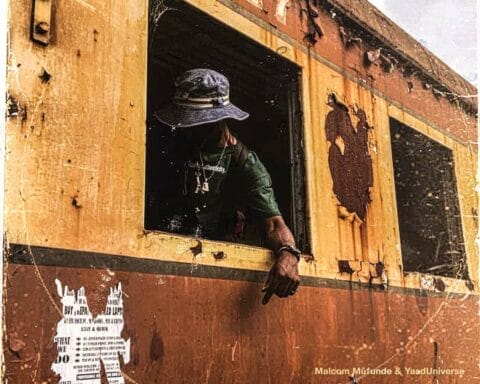European discovery
During the seventeenth century, the Portuguese has begun to dislodge the Arabs as the principal international traders on the coast of Mozambique. As they did, they began to hear stories of a king called the Monomotapa who ruled from a city called Symbãoe or Zimbãoche, some distance to the east. According to some versions of these stories, the Monomotapa’s palace was covered with plates of gold, but in 1531, Viçente Pegado, Captain of the garrison at Sofala, wrote about ruined dry-stone fortresses, a tower more than ‘twelve fathoms’ high and mines and mentioned that Symbãoe meant ‘court’ in the local language. In 1552, the Portuguese historian João de Barros (1496-1570) conjectured that it was the site of Axum, a city of the Queen of Sheba. The stories were heard second-hand from Arab merchants who traded with the peoples of the interior, but the Portuguese merchants did not travel inland.
In 1871, as Europeans began to explore the interior of southern Africa, a Swabian geologist and explorer, Karl Gottlieb Mauch (1837-1875), set out to examine the semi-legendary ruins of Monomotapa that he had heard about from the writings of a German missionary named Alexander Merensky (1837-1918), published in 1867. Setting out with an acquaintance, the ivory collector George Philips, Mauch was able to persuade a local guide to take them to the ruins of Zimbabwe. The ruins were too overgrown to examine closely, although the explorers did meet an elderly local, Babareke, who told them that he was the son of the last high priest of a cult that had once sacrificed oxen in the ruins. Other than this, Mauch and Philips were unable to learn anything about the place.During the seventeenth century, the Portuguese has begun to dislodge the Arabs as the principal international traders on the coast of Mozambique. As they did, they began to hear stories of a king called the Monomotapa who ruled from a city called Symbãoe or Zimbãoche, some distance to the east. According to some versions of these stories, the Monomotapa’s palace was covered with plates of gold, but in 1531, Viçente Pegado, Captain of the garrison at Sofala, wrote about ruined dry-stone fortresses, a tower more than ‘twelve fathoms’ high and mines and mentioned that Symbãoe meant ‘court’ in the local language. In 1552, the Portuguese historian João de Barros (1496-1570) conjectured that it was the site of Axum, a city of the Queen of Sheba. The stories were heard second-hand from Arab merchants who traded with the peoples of the interior, but the Portuguese merchants did not travel inland.
The site of Great Zimbabwe lies in the broad valley of the River Mapudzi, a tributary of the River Sabi, which enters the Indian Ocean to the south of Sofala. The landscape is granite, with small hillocks and crags, which exfoliates (cracks away) from exposed rock faces as temperatures change through the year. This provides a convenient building material, used by the builders of Great Zimbabwe and nearby sites. Soapstone, found 24 km (15 miles) away, was useful for carving, while slate and quartz were also imported to the site. The ruins of Great Zimbabwe sit on top of a steep-sided hillock and cover an area of 0.65 km2 (about 0.25 square miles). The largest structure is an elliptical enclosure (sometimes called the Temple, the Elliptical Building or the Great Enclosure), with the Acropolis at the top of the hill, 550 m (600 yards) to the north; there are other ruins in the valley bottom to the north and east. As the Arab merchants had told their Portuguese rivals, the buildings were of dry stone construction, although the walls were plastered.
The controversy begins
Like so many European explorers, Mauch published a book about his explorations when he returned to Germany; also, like so many Europeans encountering strange ruins, he tried to explain them in terms of known civilisations and cultures. He thought that Babareke had described a Semitic ritual and that the ruins were those of the biblical Ophir, the site of King Solomon’s fabled mines. One of the ruined buildings, he reasoned, was a copy of Solomon’s Temple, while the great oval enclosure (which he called Zimbabye) was a copy of the palace where the Queen of Sheba had stayed in Jerusalem. He believed that this meant that she had lived at Zimbabwe, built by Phoenician architects.
The inevitable looting follows
Mauch’s book caused a sensation in Europe and made the ruins an attraction for treasure-hunters, keen to locate Solomon’s supposed treasures. When Cecil Rhodes (1853-1902) established Southern Rhodesia in 1889 (basically a private corporation set up to administer a huge territory at considerable profit), the ruins were part of the estate of the South African settlers Willi and Harry Posselt. Willi had tried to remove a soapstone carving from one of the ruins in 1888, but was driven off by locals. According to one version of the story, in 1889, he cut a carved soapstone bird from its pillar in return for blankets and trinkets offered to a local Chief, Mugabe, and sold it to Cecil Rhodes, while yet another version claims that he hid others, intending to return to the site to collect them later. He subsequently published an account, The Early Days of Mashonaland and a Visit to Great Zimbabwe Ruins, bemoaning the lack of treasure on the site.
Archaeological excavations at Great Zimbabwe and misinterpretations
In 1891, the archaeologist James Theodore Bent (1852-1897) spent two months excavating in the ruins and was able to remove the soapstone birds, which were taken to the museum at Cape Town (they were returned to Zimbabwe in 1981). In the early years of the Southern Rhodesia colony, an Ancient Ruins Company was set up, with the express purpose of prospecting the ruins for treasure. Franchises were sold by the administrator of Mashonaland, Leander Starr Jameson (1853-1917), for forty or so sites, which yielded little more than 5 kg of gold but which destroyed their stratigraphic integrity.
Bent concluded from his excavations that the site had been built by Sabaeans, Phoenicians or another Semitic people, just as Mauch had conjectured. This was based on the presence of soapstone phalli, the shape of the conical tower and the oval shape of the Great Enclosure, which resembles a building at Ma’rib (مأرب, Yemen) identified as the harîm of Bilqîs, the Queen of Sheba. He suggested that Great Zimbabwe was identical with both the biblical Ophir and the Punt of Ancient Egyptian texts and that it had continued to flourish under Arab influence into the Middle Ages. He believed that a coin of the Roman Emperor Antoninus Pius (138-161 CE) found in a mine-shaft at Mutale (Zimbabwe, Umtali before 1982) strengthened his case. unfortunately, it seems that this is all we know about the coin.
Later explorers and archaeologists concurred with Bent’s opinion. The first was Karl (or Carl) Peters (1856-1918), the creator of German Tanganyika, who had never visited the site but who had explored ruins further east in 1899-1900. His racist attitudes (he referred to the population of Tanganyika as “sickly and useless rubbish” and believed that they should either be used by white settlers as forced labour or exterminated) clearly coloured his attitudes to who might have built the ruins.
Finally, in 1902, the new legislative council of Southern Rhodesia passed a law protecting the sites and a curator, the journalist Richard Nicklin Hall (1853-1914), was appointed to oversee Great Zimbabwe itself. Hall spent two years excavating the great enclosure, which he published in detail. He believed that he could distinguish two occupations – one sun-worshipping Semitic (perhaps Himyarite Arabs), the other medieval Arab – separated by a long period of abandonment. Hall avowedly wished to free the site “from the filth and decadence of the Kaffir occupation”, deliberately removing anything that might link the site with local African peoples and clearing some twelve feet (1.8 m) of deposits in an operation that was described by a visiting archaeologist as “reckless blundering… worse than anything I have ever seen”. As a result, Hall was dismissed from his post.
The truth will out…
However, the site was far from exhausted and further excavations were conducted by David Randall-MacIver (1873-1945) in 1905. Randall-MacIver’s conclusions were startling to the colonial administration. During his excavation campaign of 1905, he had found nothing but indigenous African artefacts and imported medieval goods (including Persian beads, glass and Chinese porcelains), all of fourteenth-century and later date. His criticism of Richard Nicklin Hall pulled no punches, sparking off a bitter debate that lasted for years.
Renewed excavations in 1929, conducted by Gertrude Caton-Thompson (1888-1985), confirmed MacIver’s discovery that the material was much later than the time of Solomon, although she was able to push the origin of the site back to the ninth or tenth century CE. In 1950, Samuel Dickson Sandes (1899-1984), Warden of Zimbabwe National Park, recovered a wooden lintel that had been used as a drain cover in the Elliptical Building, which was radiocarbon dated to 1304±55 bp, with a 98% probability of falling into the range 619-819 CE. The Rhodesian archaeologist Roger Summers was able to use this date in 1955 to suggest a slightly earlier origin, but still no earlier than the fifth century CE. Summers’ views on the indigenous origin of Great Zimbabwe and related sites brought him into conflict with the colonial administration, which was beginning to take a hard line on interpretations of the site.
Racist misinterpretation
Randall-MacIver’s discoveries did nothing to silence the proponents of external origins. As well as the Semitic origins that had long been popular, origins in southern India (Dravidian traders blown on the monsoon winds) or Malaya (the origin of the population of Madagascar) were also proposed. The Semitic origin theory had been boosted by Henry Rider Haggard’s (1856-1925) adventure novel King Solomon’s Mines, published in 1895, and this remained the most popular explanation for the ruins, despite the impossibility of the dating.
In 1930, the German ethnologist Leo Viktor Frobenius (1873-1938) announced in a Cape Town newspaper that he had identified the “source of the civilisation which created Zimbabwe and many hundreds of ruins scattered over Rhodesia, Portuguese East Africa and parts of Bechuanaland”. He placed its foundation between 4000 and 1000 BCE, much earlier than indicated by the archaeologists’ discoveries, and believed the builders to have been Sumerians from near the Caspian Sea. Frobenius also claimed that Atlantis was located in southern Africa…
It is obvious that the interpretation of site in the nineteenth and early twentieth centuries was coloured by racial prejudice on the part of white European explorers and, later, settlers. Convinced that so complex a monument could not be of indigenous African origin, explorers, antiquaries and archaeologists ignored, misinterpreted and wilfully destroyed evidence. The excavations carried out on the site for more than a century have shown beyond any doubt whatsoever that Great Zimbabwe is an entirely indigenous monument.
Where are we today?
First settled around the fifth century CE by Iron Age pastoralists of the Gokomere Culture, the great stone architecture has been found to date from the twelfth to fifteenth centuries CE. Sandes’s early radiocarbon date appeared anomalous by the late 1960s and a second sample produced a fourteenth-century date; all but four of the 28 dates now available confirm the dating of the imported ceramics and glassware. The origins of Great Zimbabwe and related sites can now be seen as an opportunistic response to the decline of the Mapungubwe kingdom, a state that lay farther south and which was characterised by its hierarchical society and wide trading links via the ancient port of Rhapta and the Islamic trading post of Kilwa Kisiwani.
Bizarrely, the possibility of a Semitic connection has been raised by DNA analysis of local Lemba people, whose claim to a Jewish ancestry on the male side appears to be confirmed. This has been suggested as the origin for apparently circumcised phallic sculptures found in some of the ruins. However, although the supposed archaeological parallels in burial practice, architectural style and so on have received a great deal of criticism, the Zimbabwean archaeologist Peter Garlake describing them as “worthless polemic”. The Wikipedia article on the Lemba people carries no hint of doubt about the claim, referring to the Lemba as a “Jewish Diasporan subethnic group”; as our understanding of the relatively new science of DNA analysis improves, we may well see these ideas either confirmed or disproved.
During the 1960s and 70s, Great Zimbabwe became a symbol of the African Nationalist movement, as the white government of Southern Rhodesia (which had issued a Unilateral Declaration of Independence from British colonial rule in 1965) suppressed the overwhelming evidence that it is indeed of African origin. The archaeologist in charge of the site during the latter years of Southern Rhodesia, Paul Sinclair, once said in an interview “I was told by the then-director of the Museums and Monuments organisation to be extremely careful about talking to the press about the origins of the Zimbabwe state. I was told that the museum service was in a difficult situation, that the government was pressurising them to withhold the correct information. Censorship of guidebooks, museum displays, school textbooks, radio programmes, newspapers and films was a daily occurrence. Once a member of the Museum Board of Trustees threatened me with losing my job if I said publicly that blacks had built Zimbabwe. He said it was okay to say the yellow people had built it, but I wasn’t allowed to mention radio carbon dates.”.
In 1964, the science-fiction writer Lyon Sprague de Camp was able to write: -“Zimbabwe had the bad luck to get caught up in the great twentieth-century dispute over differences among the races of men. Those who wanted to show that the white or Caucasoid race is better than other have been eager to show that Zimbabwe was built by whites”. Today, we are less concerned with the characteristics of whole ‘races’ because anthropologists (as opposed to political bigots) no longer view ‘race’ as a useful analytical concept.
When Southern Rhodesia achieved majority rule and became Zimbabwe in 1980, the new nation chose the name of the site to represent the entire country. Despite the political and economic problems the country has experienced since independence, Great Zimbabwe remains a potent symbol of African pride.
Bad Archeology
Source
COPY Bad Archeology (2012) Great Zimbabwe. Retrieved from http://www.badarchaeology.com/in-the-service-of-politics/great-zimbabwe. [Accessed 20 August 2019].







